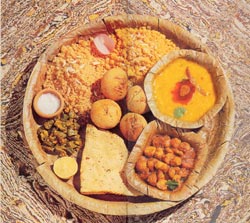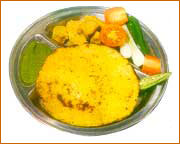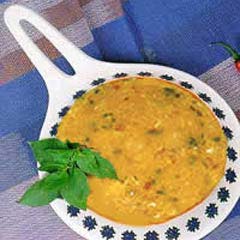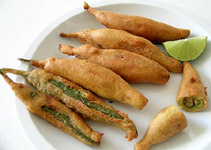Taste of Rajasthan
Rarely has the world seen so rich a cuisine from so little
that was available from the land. While the eastern region of the state has
fertile soil capable of crops of everything from wheat and maize to millets and
corn, for much part the desert's dry terrain, prone to droughts, was incapable
of producing even basic necessities of survival. Yet, live and eat they did,
creating an exotic cuisine from the soil that threw up a few pulses, crops of
millet, and trees with beans that were dried and stored for use when, in the
summers, nothing would grow.

Communication and faster means of transportation have brought in a revolution
in the choice of vegetables and fruits that are now available throughout the
state, but this was not always so. Which is why, for the village, his diet
still remains sparse, and consists of dairy produce, bread of millets and
accompaniment of gram flour and sour buttermilk which, say dieticians across
the world, is a high-protein, low-fat cuisine. Perhaps that is what gives the
people of the desert their erect gait and slender build.
Though the Rajasthani kitchen was able to create much from little, it had also
to cater to different communities with their own ritual observances. The Rajput
warrior, for example, was not averse to shikar, killing game to put in his pot
at night. The Vaishnavs, followers of Krishna, wer vegetarian, and strictly so,
as were the Bishnois, a community known for their passion to conserve both
animal and plant life. Even among the Rajputs, there were enough royal kitchens
where nothing other than vegetarian meals were cooked. The Marwaris, of course,
were vegetarian too, but their cuisine, though not too different from the
Rajputs, was richer in its method of preparation. And then there were the Jains
too, who were not only vegetarians, but who would not eat after sundown, and
whose food had to be devoid of garlic and onions which were, otherwise,
important ingredients in the Rajasthani pot.

To begin with the Rajput, then: as a hunter-warrior, he often
bagged his game, which is why the Rajasthani repertoire has everything form
venison and hare to wild boar on its menu. However, since these are banned by
the government for fear of endangering these wild species, the Rajasthani meal
has almost come to in imply mutton. The Rajput is a recent, reluctant convert
to chicken, and even though to lakes abound in fish, it rarely finds its way
into his kitchen.
An important feature of non-vegetarian cooking in the Rajput kitchen was that
it was-rarely cooked on the main stove in the kitchen, and usually employed the
male head of the family as its chef. Essential ingredients included, besides
onions kachri, which is part of the cucumber family, as a marinade. The meat,
first basted in the spices and then roasted in a pot over a wood fire, was
turned into gravy and eaten with millet rotis.
Colonel James Tod's treatise, Annals and Antiquities of Rajputana, notes that
'the Rajput hunts and eats the boar and deer, and shoots duchks and wild fowl'.
But though the Rajput is a meat-eater, he is by no means a passionate one who
has to have mutton on his table for every meal. Vegetarian food too forms a
large part of his diet, Game, in fact, has been a part of the creed of the
warrior: when out camping in the desert it is what is available that forms the
basis of the next meal. And so too, when the rest of the country follows
strictly rigid vegetarian protocol as during the celebration of Navratri, the
festival of nine nights, the Rajput offers his Devi a goat as sacrifice,
beheading the beast with one blow of his sword. On all nine days, a similar
offering is made, and the cooked meat eaten as consecrated food. In Rajasthan,
most families will arrange for at least one such sacrifice during the festival,
and sometimes goats are specially reared in family backyards for the ritual
offering.
Shikar provided a meal for the family, or for the village, or else expediton
members shared the spoils to take their individual portions home. However, if
there was more meat than could be consumed, it was pickled for later
consumption. Venison and pork, especially, were cooked in rich masalas before
being preserved in oil and vinegar. Pork fat, called sauth, was kept for winter
days, when it would be chewed as prevention against colds.

Since men often did the cooking themselves, and since
expeditions away from home for reasons of war rarely allowed the luxury of
well-equipped kitchens, a more rudimentary method of barbecuing created its
distinctive style of desert cooking. When small animals were bagged, such as
desert hare, the animal was cleaned, stuffed and allowed to cook in a sand pit
with a bed of live coals covering it, often overnight. with large animals, this
was not possible, so the meat was marinated using kachri to impart its
distinctive tang, and then this was barbecued over a bed of live coals. This,
called sula, is still considered a delicacy, and has a tangy flavour on account
of the sour marinade.
The women, whether the family was vegetarian or meat eating, has their task cut
out for them. They would dry the meagre sangri and gwarphali beans that are
eatable, and store them for future use. They would also make papads and endless
other variations and dry them, also for storage, later to be turned into
curries for the family. Once again, using onions and garlic, and with mustard,
red chilli powder and a handful of other spices, these would be put on the
family pot in the kitchen, with yoghurt for flavouring. Accompaniments rarely
changed over the region. Karhi, more popularly known as khatta, formed- as it
continues today- a part of the staple diet. Made with buttermilk (thin form of
yogurt), it is mixed with chickpea flour and allowed to cook with mustard seeds
and crushed garlic clover. The longer it stays of the fire, the better its
taste. Usual vegetables are sangri and gwarphali, beans stonred for the length
of the year after drying, and cooked in yogurt and masalas. Papads, eaten
roasted elsewhere in Indian, are also gravied in Rajasthan, as is bhujiya, a
popular moth-lentil snack. Chickpea flour can be freshly rolled out as dumling
to make gatte-ka-saag, while sundried moth-lentil dumplings are also cooked as
badi-ka-saag.
These are all eaten with either bread consisting millet bread, cooked over wood
fires, or a porridge made using millet gains and moth lentils cooked together
with water, a little spice and some ghee, to make khichra, a more filling, more
potent version of what elsewhere in India is called khichri (though this uses
rice as its base). Khichra, the night mainstay of the state's farming
communities, is eaten with ghee, and accompanied by either jaggery or karhi.
The day's meal for the working class consists of bajra rotis eaten with
moth-daal, or with a fiery red-chilli-and-garlic chutney and washed down with
raabori, millet flour cooked in buttermilk, believed to be extremely cooling in
the summer heat of the state. Desserts were, by and large, rare, though exotic
concoctions from vegetables were sometimes served. For most, for festive
occsions, these would consist of seera, a halwa made of cooked wheat flour in
ghee, or laapsi, a porridge made with dessiccated grains of wheat. Rice, a
delicacy in Rajasthan, was served as a sweet with the addition of sugar,
saffron and dried nuts and raisins. Many more vegetables are now available in
Rajasthan, with even little towns made colourful with the produce of vegetable
vendors. Most of these vegetables are cooked in the same way as its chichkpea
and lentil-based corries, and there are usually no distinctive recipes that
allow the taste of one vegetable to differ from another.

The Marwaris, however, were considerably more lavish with the inputs in their
kitchen. A typical meal for them could consist of pishta-lonj served with a
glass of milk laced with cream. Them, puris fried in hot oil, made with both
wheat flour as well as with matter added to turn them a lovely green. With it,
tamatar-ki-sabji, a tomato curry, at once sweet and sour and hot, gatte-ka-saag
with shvings of cashew added, and sangri-ker-ka-saag with the oil oozing out,
and dahi-bhallas, of course. This would be followed by sooji-ka-halwa, a
pudding that's easy to make but still a daily favourite, and perhaps a glass of
lassi at the end of the meal.
Marwari food uses the same basic ingredients of the state's Rajputs, but is a
richer verion, with more spices and herbs being added to the masala, and cooked
in more fat. The Marwaris eat two meals, in the morning and at sundown. Both
consist of a great variety of rotis and puris puffed in piping hot oil. There
are a large number of accompaniments by way of chutneys, some sweet, others
sour. Gatta, sangri and a tomato vegetable curry are favourites, all of them
cooked in a good deal of clearified butter, the sour taste of the flavouring
ingredients cutting through the fat to create its own distinctive taste. Ker, a
hard desert berry, is often added to pickles, or sangri, or cooked on its own.
The amount of chillies used is somewhat more curtailed, and mango powder
(amchur) and rai (mustard seeds) dominate. The Marwaris also prefer heeng or
asafoetida over the Rajput preference for garlic.
The Marwari sweet tooth is legendary, and since they were traders, they had
greater access to the markets not only of India but also South-east Asia. They
were, therefore, able to store dry fruits such as almonds, pistachios, cashews,
and together with poppy seeds (khus) were able to use them in their puddings.
Halwas, barfis and ladoor are part of the Marwari repertoire, along with til,
sesame, which was used for both sweets as well as main courses. Dairy has
played an important role in the economy of the desert, especially since
agriculture could never be taken for granted. The consumption of milk, and of
buttermilk and yoghurt formed a part of the main diet, but with the exception
of those regions with access to rice-growing areas, the rice-rice, milk, sugar,
clarified butter, nuts, spices, dry fruits are blended and cooked, attendants
at the shrine jump into its scalding centre, to serve it as a holy offering to
the pilgrims, the contents dramatically diminishing as the waiting crowds
consume it as prasad. This, of course, is an occasional offering. Most days,
the large tureens serve a mixture of rice, meat and lentils- a meal in one go.